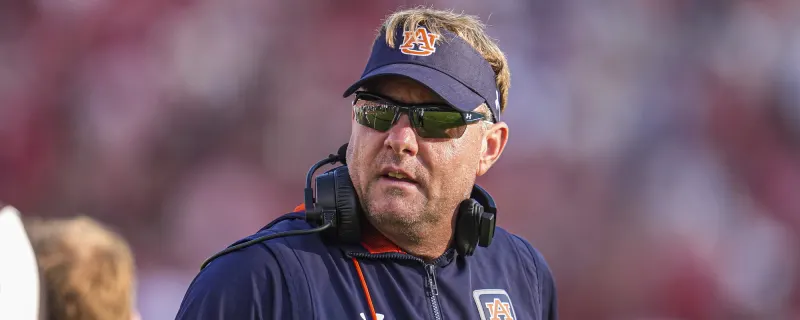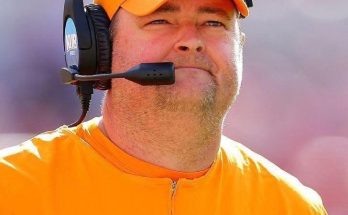The saga of Auburn University’s football program over the past several years has been nothing short of tumultuous. Once a prominent contender in the SEC, the Tigers fell into a state of disarray that many believed would take years to fix. From internal strife to inconsistent performances on the field, the previous coaching staff left behind a program in need of significant overhaul. However, a new chapter in Auburn football has begun, as Hugh Freeze has taken the reins and started the monumental task of rebuilding a program that had fallen from grace.
The previous coaching tenure, marked by Bryan Harsin’s ill-fated leadership, left a lasting impact on the Tigers. Harsin’s stint at Auburn was filled with controversy, instability, and a lack of on-field success. The program was plagued by underperformance, inconsistent recruiting, and off-field distractions, all of which made it difficult to find any sustained success. Harsin was ultimately dismissed in the middle of the 2022 season, and the program was left in turmoil.
Enter Hugh Freeze, a coach with a proven track record of rebuilding programs and a reputation for turning struggling teams into competitive contenders. Freeze, who had success at Liberty University and previously at Ole Miss, was tasked with cleaning up the mess left behind by his predecessor. His arrival at Auburn was met with optimism, as many believed that Freeze was the right man to bring stability, structure, and success back to the program.
In this article, we will explore the disastrous state of Auburn football when Harsin left, the challenges Freeze has faced since his hiring, and how he has started the process of cleaning up the mess and restoring the Tigers to relevance.
The Collapse Under Bryan Harsin
The Auburn football program’s fall from grace began when Gus Malzahn was dismissed after the 2020 season. Malzahn, who had led the Tigers to a national championship appearance and several major bowl games, was let go following a disappointing 6-4 season in 2020. The decision to fire Malzahn was controversial, as many Auburn fans and analysts believed he had earned at least one more season to turn the program around. But Auburn’s athletic director, Allen Greene, opted to make a change, hiring Bryan Harsin away from Boise State.
Harsin’s hiring was met with skepticism from the start. The decision to bring in a coach with no ties to the SEC raised eyebrows, as many wondered how he would adjust to the brutal competition of the Southeastern Conference. The early signs were not promising, as Auburn’s offense struggled under Harsin’s system, and the team failed to live up to expectations in his first season.
In his first year (2021), Harsin’s Tigers posted a 6-7 record, and while the team showed flashes of promise, they lacked consistency. The offense sputtered at times, and the defense, which had been a strength under Malzahn, took a noticeable step back. Throughout the season, there were signs of internal issues and a lack of cohesion within the program. Discontent among the players, fans, and boosters began to grow, and whispers of Harsin’s inability to connect with the Auburn community started to surface.
By 2022, things had reached a breaking point. The Tigers limped through the season with a 3-5 start, and it was clear that the relationship between Harsin and the program was fractured. Recruiting struggles were another major issue, as the Tigers were unable to land the high-level talent necessary to compete in the SEC. Harsin’s tenure became increasingly marred by internal conflict, lack of leadership, and an overall sense that the program was headed in the wrong direction.
In February 2022, Auburn football faced a crossroads. After a series of losses on the field and a lack of support behind the scenes, Harsin was fired midseason, leaving the program in disarray. The turmoil surrounding Harsin’s firing and the subsequent leadership vacuum only deepened the challenges the Tigers would face in the coming years.
Hugh Freeze Takes Over: A New Beginning for Auburn
In the wake of Harsin’s departure, Auburn turned to Hugh Freeze to restore order and stability to the program. Freeze’s hiring was met with a sense of cautious optimism. While his tenure at Ole Miss had been clouded by NCAA violations and controversy, Freeze had proven himself to be a highly effective coach who could turn a program around. At Liberty, he transformed the Flames into a competitive team, securing multiple bowl appearances and establishing a high-powered offense.
Auburn’s decision to bring in Freeze was strategic. The Tigers needed someone with experience, leadership, and a proven track record of success. Freeze checked all the boxes. He had a deep understanding of the SEC, having spent several years coaching at Ole Miss, and he had a reputation for developing quarterbacks and offensive systems that could keep pace with the high-scoring offenses in the SEC.
Freeze’s first task was to restore confidence within the program. He needed to build trust with the players, coaching staff, and the Auburn community, all of whom had been scarred by the instability of the previous regime. Freeze quickly made it clear that he was committed to making Auburn football relevant once again. He began by re-establishing strong relationships with recruits and high school coaches throughout the state of Alabama, a key recruiting pipeline for the Tigers.
Rebuilding the Roster: Freeze’s Approach to Recruiting
One of the most pressing issues Freeze inherited was the state of Auburn’s roster. The Tigers had lost key players due to transfers and had failed to land a consistently strong recruiting class in recent years. The program’s lack of depth, particularly at key positions such as quarterback and offensive line, made it difficult to compete in the SEC.
Freeze immediately set to work addressing these issues by targeting key players through the transfer portal and focusing on recruiting talent that could step in and make an immediate impact. He brought in multiple experienced players to fill gaps in the roster, including quarterbacks, offensive linemen, and defensive playmakers.
Additionally, Freeze prioritized building relationships with high school recruits. He understood that while the transfer portal was an essential tool, Auburn’s long-term success would depend on its ability to develop a sustainable recruiting pipeline. Freeze’s efforts in recruiting were evident in the 2023 and 2024 recruiting cycles, as Auburn secured several highly-ranked players, including quarterback Hank Brown and wide receiver Harlan Hightower. His ability to recruit players who fit his offensive and defensive schemes was a critical step in rebuilding the foundation of Auburn football.
Restoring Auburn’s Identity: Focus on Culture and Leadership
Beyond roster improvements, Freeze’s most significant challenge was changing the culture within the program. Under Harsin, the Tigers had lacked a clear sense of direction and purpose, and players were often left feeling disconnected from the leadership. Freeze’s leadership style, which emphasized accountability, discipline, and team-first mentality, quickly began to resonate with players.
Freeze made it clear that his program would prioritize discipline both on and off the field. He emphasized the importance of character, team unity, and hard work. This approach was a stark contrast to the atmosphere under Harsin, where players often voiced concerns about communication breakdowns and a lack of guidance from the coaching staff. Freeze’s approach to leadership included regular meetings with players to ensure their concerns were heard and addressed. His willingness to connect with the players on a personal level was a crucial step in rebuilding Auburn’s fractured locker room.
Another significant aspect of Freeze’s rebuild was his offensive philosophy. Known for his high-tempo, up-tempo offensive style, Freeze sought to inject new life into Auburn’s offense, which had been stagnant under Harsin. His success at Liberty, where he developed one of the most potent offenses in college football, provided a blueprint for what he wanted to implement at Auburn. The Tigers’ offense quickly became more dynamic under his leadership, with a focus on quarterback development, innovative schemes, and aggressive play-calling.
On-Field Improvement and Optimism for the Future
As the 2025 season progresses, it is clear that Hugh Freeze’s efforts to clean up the mess left by the previous coaching staff are beginning to pay off. While the team has faced some growing pains, Auburn is already showing signs of improvement in key areas. The Tigers are more competitive in SEC play, and their recruiting efforts have produced immediate results. Freeze’s ability to adapt and build a team that reflects his vision has been one of the most encouraging signs for Auburn fans.
The Tigers’ offense has become more explosive, and while there are still areas to improve, it is evident that Freeze’s offensive philosophy is beginning to take root. The development of Auburn’s quarterbacks, in particular, is an encouraging sign that Freeze can work his magic with talented signal-callers.
Defensively, Freeze has made strides in rebuilding Auburn’s once-dominant defense. While it may take a few more seasons to reach the level of elite SEC defenses, the Tigers are much more disciplined and fundamentally sound than they were under Harsin.



